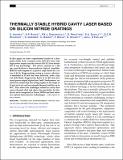Files in this item
Thermally stable hybrid cavity laser based on silicon nitride gratings
Item metadata
| dc.contributor.author | Iadanza, S. | |
| dc.contributor.author | Bakoz, A. P. | |
| dc.contributor.author | Singaravelu, P. K. J. | |
| dc.contributor.author | Panettieri, D. | |
| dc.contributor.author | Schulz, S. A. | |
| dc.contributor.author | Devarapu, G. C. R. | |
| dc.contributor.author | Guerber, S. | |
| dc.contributor.author | Baudot, C. | |
| dc.contributor.author | Boeuf, F. | |
| dc.contributor.author | Hegarty, S. | |
| dc.contributor.author | Whelan-Curtin, John William | |
| dc.date.accessioned | 2019-07-30T23:41:34Z | |
| dc.date.available | 2019-07-30T23:41:34Z | |
| dc.date.issued | 2018-08-01 | |
| dc.identifier | 258700555 | |
| dc.identifier | 088bf6f2-639e-451d-96ce-31f2a939c5a5 | |
| dc.identifier | 85051278770 | |
| dc.identifier | 000440439900028 | |
| dc.identifier.citation | Iadanza , S , Bakoz , A P , Singaravelu , P K J , Panettieri , D , Schulz , S A , Devarapu , G C R , Guerber , S , Baudot , C , Boeuf , F , Hegarty , S & Whelan-Curtin , J W 2018 , ' Thermally stable hybrid cavity laser based on silicon nitride gratings ' , Applied Optics , vol. 57 , no. 22 , pp. E218-E223 . https://doi.org/10.1364/AO.57.00E218 | en |
| dc.identifier.issn | 1559-128X | |
| dc.identifier.other | crossref: 10.1364/AO.57.00E218 | |
| dc.identifier.other | ORCID: /0000-0001-5169-0337/work/56862236 | |
| dc.identifier.uri | https://hdl.handle.net/10023/18209 | |
| dc.description | Funding: Science Foundation Ireland (SFI) (16/ERCS/3838, SFI12/RC/2276); Engineering and Physical Sciences Research Council (EPSRC) (EP/L017008/1, EP/L505079/1); H2020 LEIT Information and Communication Technologies (ICT) (COSMICC nr. 688516, H2020-ICT27-2015); H2020 European Research Council (ERC) (337508) | en |
| dc.description.abstract | In this paper, we show the experimental results of a thermally stable Si3N4 external cavity (SiN EC) laser with high power output and the lowest SiN EC laser threshold to our knowledge. The device consists of a 250 μm sized reflective semiconductor optical amplifier butt-coupled to a passive chip based on a series of Si3N4 Bragg gratings acting as narrow reflectors. A threshold of 12 mA has been achieved, with a typical side-mode suppression ratio of 45 dB and measured power output higher than 3 mW. Furthermore, we achieved a mode-hop free-lasing regime in the range of 15–62 mA and wavelength thermal stability up to 80°C. This solves the challenges related to cavity resonances’ thermal shift and shows the possibility for this device to be integrated in dense wavelength-division multiplexing (WDM) and heat-intensive optical interconnects technologies. | |
| dc.format.extent | 939681 | |
| dc.language.iso | eng | |
| dc.relation.ispartof | Applied Optics | en |
| dc.subject | QC Physics | en |
| dc.subject | T Technology | en |
| dc.subject | NDAS | en |
| dc.subject.lcc | QC | en |
| dc.subject.lcc | T | en |
| dc.title | Thermally stable hybrid cavity laser based on silicon nitride gratings | en |
| dc.type | Journal article | en |
| dc.contributor.sponsor | European Commission | en |
| dc.contributor.sponsor | European Research Council | en |
| dc.contributor.institution | University of St Andrews. School of Physics and Astronomy | en |
| dc.contributor.institution | University of St Andrews. Microphotonics and Photonic Crystals Group | en |
| dc.identifier.doi | 10.1364/AO.57.00E218 | |
| dc.description.status | Peer reviewed | en |
| dc.date.embargoedUntil | 2019-07-31 | |
| dc.identifier.url | https://cora.ucc.ie/handle/10468/7158 | en |
| dc.identifier.grantnumber | 688516 | en |
| dc.identifier.grantnumber | 337508 337508 | en |
This item appears in the following Collection(s)
Items in the St Andrews Research Repository are protected by copyright, with all rights reserved, unless otherwise indicated.

